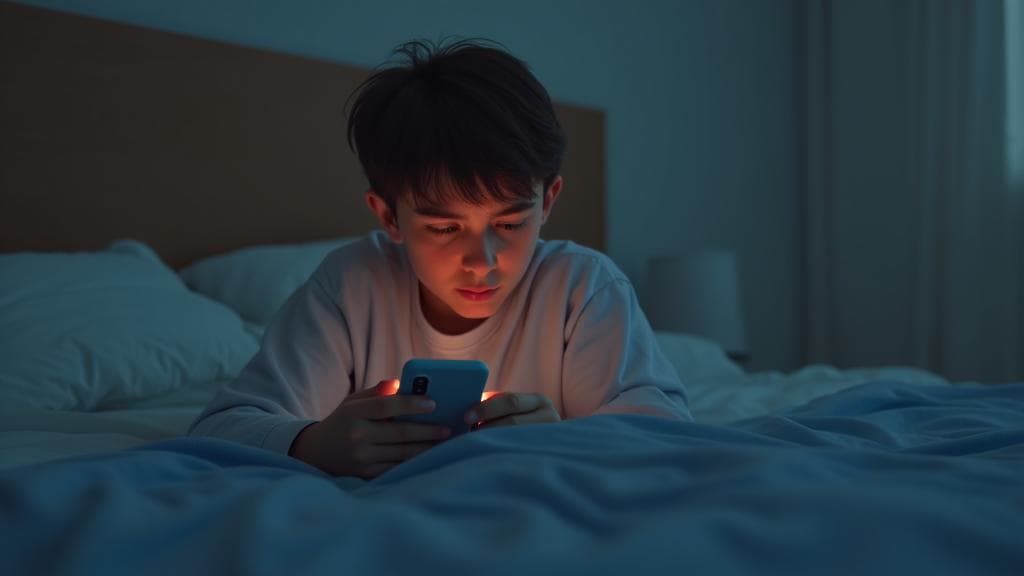
Introduction
Excessive gadget use among students has become a significant concern, impacting their mental well-being. Prolonged screen time is linked to various mental health issues, including increased levels of stress, anxiety, and depression. Students are spending more time on their devices, often at the expense of physical activities and face-to-face interactions.
Managing screen time is crucial for fostering a healthier lifestyle. Limiting gadget use can help mitigate the negative effects on mental and physical health, improving overall well-being. This article will provide you with 5 strategies to control the excessive use of gadgets, offering practical solutions to balance technology usage.
What you'll learn:
- The impact of excessive gadget use on students' mental health
- The importance of Managing screen time
- Five actionable strategies to reduce dependence on gadgets
Understanding the Problem of Excessive Gadget Use Among Students
What is Excessive Gadget Use?
Excessive gadget use means spending too much time on electronic devices like smartphones, tablets, and computers. This has become a common issue among students.
How Common is This Problem?
Studies show that many students spend over 6-8 hours a day on their gadgets. This often takes away from important activities like exercise and socializing in person.
How Does Gadget Use Affect Mental Health?
Several statistics highlight the extent of this issue:
- According to a report by Common Sense Media, teenagers average about 7 hours and 22 minutes per day on screens for entertainment purposes.
- A survey conducted by Pew Research Center found that 45% of teens are online almost constantly.
This excessive screen time is closely tied to mental health issues. Research has consistently shown a correlation between high levels of gadget usage and increased rates of stress, anxiety, and depression among students.
What Are the Negative Effects of Too Much Screen Time?
The negative outcomes connected to prolonged gadget usage are significant:
- Stress and Anxiety: Spending long hours on screens can elevate stress levels. Constant notifications and social media pressures contribute to anxiety disorders.
- Social Isolation: Heavy reliance on digital interactions often leads to reduced face-to-face communication skills, resulting in feelings of loneliness and social isolation.
- Cognitive Impairments: Overuse of gadgets affects cognitive functions. Studies suggest that it can hinder attention span, memory retention, and critical thinking abilities.
How Too Much Screen Time Affects Your Mind and Body
Spending too much time on screens can have serious effects on both your mind and body, especially for students. Let's break down how it impacts mental health, physical health, and cognitive development.
Mental Health
Using gadgets excessively is strongly connected to a higher risk of mental health problems like depression and anxiety. Constantly being exposed to social media can make you feel inadequate and lonely. It's even worse when students compare themselves to their peers, leading to low self-esteem.

- Increased Anxiety: Getting constant notifications and feeling the need to stay updated with online activities can cause high stress levels.
- Depression: Living a sedentary lifestyle, often accompanied by too much screen time, can contribute to depressive symptoms due to lack of physical activity and real-life social interactions.
Physical Health Issues
Spending long hours in front of screens also has noticeable effects on your physical well-being. Students are experiencing sleep disorders and obesity more frequently because of excessive gadget use.
- Sleep Disorders: The blue light emitted from screens messes with the production of melatonin, a hormone crucial for sleep. This leads to disrupted sleep patterns and insomnia.
- Obesity: Sitting around too much due to excessive screen time plays a big role in weight gain. Not moving enough combined with unhealthy eating habits while using gadgets makes this problem worse.
Cognitive Impairments
Being exposed to screens for extended periods affects cognitive development, especially in younger children.
- Language Development Concerns: Kids who spend more time on gadgets often show delayed language skills because they don't have as many face-to-face interactions.
- Attention Deficits: Constantly engaging with fast-paced digital content can make it hard for a child to concentrate on slower-paced tasks, leading to attention deficit issues.
Understanding these impacts is crucial for coming up with effective ways to reduce the negative effects of excessive screen time among students.
5 Practical Strategies to Control Excessive Gadget Use Among Students
Strategy 1: Set Time Limits for Gadget Use
Setting specific time limits for using gadgets is crucial in reducing the negative effects of too much screen time. By creating a structured schedule, you can ensure that students have a balanced daily routine that includes time for other essential activities such as studying, physical exercise, and social interactions.
Why It's Important:
- Reduces Dependency: Limiting gadget usage helps break the cycle of continuous screen engagement, fostering healthier habits and preventing technology addiction.
- Promotes Balance: Ensures that students allocate adequate time for various activities contributing to their overall well-being.
- Prevents Overuse: Setting boundaries can prevent the negative psychological and physical impacts linked to excessive gadget use, as outlined in this Scientific Direct article.
Tools and Apps for Monitoring and Controlling Screen Time:
There are several tools and apps available to help you monitor and control screen time effectively:
- Parental Controls: Most modern devices come with built-in parental controls that allow you to set daily screen time limits, block specific apps during study hours, and even monitor usage statistics. For more information on how to effectively use these features, check out this eSafety guide on parental controls).
- Screen Time Apps: Applications like Family Link (for Android) and Screen Time (for iOS) provide detailed insights into gadget usage patterns, enabling you to set and enforce limits.
- Digital Wellbeing Features: Many devices now include features like Digital Wellbeing on Android or Screen Time on iOS, which help track usage, set app timers, and control notifications.
Implementing This Strategy:
- Set Clear Rules: Define clear rules about when gadgets can be used. For example, no screens during meals or before bedtime.
- Create a Schedule: Develop a daily or weekly schedule that includes designated times for gadget use alongside other activities.
- Use Timers: Utilize built-in timers or third-party apps to set reminders for breaks from screens.
By integrating these measures into daily routines, you can significantly reduce the risks associated with excessive gadget use while promoting a healthier lifestyle for students.
You may be interested in:
Strategy 2: Encourage Outdoor Activities as Alternatives to Screen Time
Engaging in outdoor activities is a powerful method to limit gadget usage and promote a healthy lifestyle. These activities offer numerous benefits, including the reduction of stress and anxiety, improvement of physical health, and enhancement of social skills.
Benefits of engaging in outdoor activities:
- Physical Health: Regular physical activity helps prevent obesity, improves cardiovascular health, and strengthens muscles.
- Mental Well-being: Nature and fresh air can significantly reduce feelings of stress and anxiety.
- Social Interaction: Outdoor settings often encourage group activities, fostering teamwork and communication skills.
Examples of fun and stimulating outdoor activities for students:
- Sports: Joining a local soccer team or participating in school sports can be both enjoyable and beneficial for physical fitness.
- Nature Walks and Hikes: Exploring local parks or hiking trails provides an excellent way to connect with nature.
- Cycling: Riding bicycles around the neighborhood or on designated trails can be a thrilling adventure for children.
- Gardening: Engaging in gardening projects can teach responsibility while also being therapeutic.
- Playgrounds and Recreational Areas: Visiting playgrounds allows kids to be active while interacting with peers.
Incorporating these activities into daily routines encourages students to spend less time on gadgets and more time enjoying the world around them. This approach aligns with mindful technology use by offering enjoyable alternatives that contribute to overall well-being.
Strategy 3: Foster Real-Life Connections Beyond the Digital Realm
Promoting real-life social interactions is crucial for reducing gadget dependency. Encouraging activities like family gatherings and community events helps limit gadget usage and enhances emotional well-being.

Family Gatherings
- Game Nights: Organize weekly game nights with board games or card games that encourage family bonding.
- Cooking Together: Prepare meals as a family, which not only limits gadget usage but also fosters teamwork and communication.
- Storytelling Sessions: Share stories from each family member's day, creating an opportunity for meaningful conversations.
Community Events
- Local Festivals: Participate in local cultural or seasonal festivals to engage with your community.
- Sports Leagues: Sign up for community sports leagues or fitness classes to promote physical activity and social connections.
- Volunteer Work: Encourage participation in community service projects, which build empathy and a sense of responsibility.
Cultivating these real-life connections offers several benefits:
- Emotional Well-being: Real-world interactions help reduce feelings of loneliness and anxiety commonly linked to excessive screen time.
- Relationship Building: Regular face-to-face communication strengthens relationships by building trust and understanding.
Adopting these practices can make it easier to monitor app usage and develop mindful technology use habits. This aligns with the broader goal of implementing the 5 strategies to control the excessive use of gadgets, ensuring a balanced lifestyle.
Strategy 4: Create Gadget-Free Zones at Home to Encourage Quality Interactions
Designating specific areas in your home where gadgets are not allowed can significantly limit gadget usage and promote face-to-face communication. Consider creating gadget-free zones in spaces like the dining room or living room, where family members can engage in meaningful conversations without the distraction of screens.
Implementing these zones enhances family bonding and strengthens relationships. Here are a few benefits:
- Improved Communication: Family members are more likely to talk and share experiences when gadgets are not within reach.
- Quality Time: These zones encourage activities like board games or storytelling, which foster closer connections.
- Mindful Technology Use: Establishing gadget-free zones sets a precedent for mindful technology use, helping everyone recognize when it is appropriate to engage with screens.
By setting clear boundaries around device usage, you create an environment that values personal interactions over digital distractions. This strategy aligns with the overarching goal of the 5 strategies to control the excessive use of gadgets, aiming to build healthier habits and stronger family ties.
Strategy 5: Be Mindful of Technology Consumption Habits for Balanced Usage
Developing awareness about how you use gadgets is crucial for maintaining a balanced lifestyle. Limit gadget usage by being conscious of the time spent on screens and understanding personal device usage patterns. Keeping a screen time journal can be an effective method for tracking and reflecting on your daily interactions with technology.
Several tools and apps are available to help monitor app usage and encourage mindful technology use:
- Screen Time (iOS): Provides detailed reports on how much time you spend on different apps.
- Digital Wellbeing (Android): Offers insights into your phone usage and helps set app timers.
- RescueTime: Tracks time spent on various websites and applications, offering productivity insights.
Engaging in periodic self-reflection about your tech habits can lead to more informed decisions about when and how to use gadgets. Consider setting aside specific periods throughout the day to unplug and focus on non-digital activities. This approach not only helps limit gadget usage but also enhances your overall quality of life.
Conclusion: Finding Balance in a Tech-Savvy World
Implementing the 5 strategies to control the excessive use of gadgets can significantly reduce gadget dependency and foster healthier technology habits.
- Start by setting time limits, promoting outdoor activities, fostering real-life connections, creating gadget-free zones, and being mindful of your technology consumption habits.
- Embrace a balanced approach towards gadgets. Enjoy their benefits while maintaining a healthy lifestyle.
Taking these steps helps ensure that technology remains a tool for enhancement rather than a source of stress or isolation.
FAQs (Frequently Asked Questions)
What is excessive gadget use and why is it a concern for students?
Excessive gadget use refers to the over-reliance on digital devices, which has become prevalent among students. It is a concern because studies have shown a correlation between high screen time and mental health issues such as stress, anxiety, and social isolation.
What are the psychological impacts of excessive screen time?
Excessive screen time can lead to increased risks of depression and anxiety disorders. It can also contribute to cognitive impairments and issues with language development in children due to prolonged exposure to screens.
What are some practical strategies to control excessive gadget use?
Five practical strategies include setting time limits for gadget use, encouraging outdoor activities as alternatives, fostering real-life connections beyond digital interactions, creating gadget-free zones at home, and being mindful of technology consumption habits.
How can setting time limits help manage gadget usage?
Establishing specific timeframes for using gadgets helps create boundaries that can reduce overall screen time. Tools and apps are available for monitoring and controlling screen time, making it easier for students to adhere to these limits.
Why is it important to encourage outdoor activities among students?
Engaging in outdoor activities provides students with fun alternatives to screen time. It promotes physical health, reduces dependence on gadgets, and enhances overall well-being by offering stimulating experiences in nature.
What role do gadget-free zones play in family interactions?
Creating designated areas at home where gadgets are not allowed encourages face-to-face communication. This practice enhances family bonding and strengthens relationships by promoting quality interactions without the distraction of technology.

